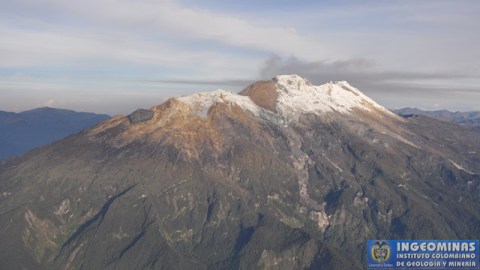Potential hazards of continued dome growth on Colombia’s Nevado del Huila

Earlier today, Dr. Boris Behncke posted a link to some fascinating images of the dome growing at the summit of Nevado del Huila (see below) in Colombia. The volcano started erupting again in 2007 after what is thought to be almost 500 years of quiet. The eruptions since 2007 have been relatively passive – VEI 2-3 explosions and dome growth. However, in 2008, the volcano produced a 50,000 feet ash plume that lead to “one of the world’s largest” lahars that did cause some fatalities (but nothing compared to the 1985 lahars from Nevado del Ruiz that killed over 20,000, a testament to the improvements that INGEOMINAS has made in volcano monitoring). Huila, in fact, produced its deadliest volcanically-related event when it wasn’t erupting – in 1994, an avalanche and lahar from the volcano swept down the Rio Paez valley to the south, killing hundreds and leaving over 20,000 people homeless. This event was not triggered by an eruption but rather a M6.4 earthquake causing the loosely-consolidated volcanic debris to slide down the volcano, likely a common event in volcanic terrains.
A view of the summit area of Nevado del Huila in Colombia showing the growth of the summit dome. Image by INGEOMINAS, taken on January 25, 2011.
The images posted by INGEOMINAS in last January show a steep-sided dome growing at the summit of Huila. IR images of the dome show that the material, like andesite or dacite, is hot (not surprisingly) and the dome appears to be continuing to grow. This means that the threat of a dome-collapse pyroclastic flow (or block-and-ash flow, similar to those at Soufriere Hills) will rise as the dome’s sides steepening. Now, looking at a map of the region near Huila, we can see that it is surrounded by National Park, so in all likelihood, pyroclastic flows wouldn’t be a direct danger to surrounding communities. However, as the 1994 and 2008 lahars show, if the ash and debris from potential pyroclastic flows become remobilized or mix with water/snow, lahars are likely to be the product*.
The current status at Huila is Yellow Alert status, which suggests continued unrest at the volcano. Seismicity and increased fumarolic activity at the summit called for brief evacuations near the volcano, but it appears that the geologist at the Popayan Volcano Observatory don’t think the activity is abnormal: “We conclude that the volcanic phenomenon presents fluctuations characteristic of the current activity level.” However, if dome growth continues, the new threat might come from a collapse rather than an eruption. Remember, you can see the activity at Huila on one of the two webcams pointing at the Colombian peak.
*Note: Normally, John Seach is an excellent source for volcano information. However, I have never heard of lava flows, especially andesitic or dacitic, moving at 40 km/hr like he mentions in his page for Huila. I consider this questionable unless I (or you) can find any corroborating information). My guess is he means lahars (?)
Top left: Another view of the summit of Huila, showing the new dome on January 25, 2011. Image by INGEOMINAS.





